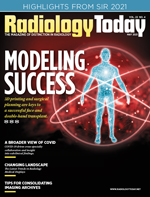 Editor’s Note: Collaborative Effort
Editor’s Note: Collaborative Effort
By Dave Yeager
Radiology Today
Vol. 22 No. 4 P. 3
Accomplishing big things often requires multiple people working together. Whether it’s building the pyramids of Giza, sending a rover to Mars, or performing a complicated operation, various types of expertise are needed for successful implementation. This month, we’re looking at some of the ways that collaboration can improve medical care. In areas large and small, multidisciplinary thinking is making measurable changes in the ways health care is delivered, and that’s a trend that is likely to continue. This month’s features examine various modes of collective work that are affecting and, in some cases, transforming, health care.
Our cover feature, by Beth W. Orenstein, reports on the role 3D printing played in a face and double-hand transplant; the operation was the first successful procedure of its kind. By making 3D models from CT scans, a team of surgeons was able to plan and strategize their approach for several possible scenarios, even during the pandemic. The success of the operation was a true team effort between the surgeons and their technology partner, and it points the way toward successful future procedures that have to the potential to greatly improve patients’ quality of life.
Another collaboration, between radiologists and cardiologists, is taking place on the COVID front. Although COVID is often thought of as a lung disease, new research is finding that it affects many body systems. Aine Cryts reports on an MRI study from the University of Pennsylvania that found signs of COVID in patients’ cardiovascular systems.
If you’re wondering what’s new in medical displays, Keith Loria has the details. Among other things, the newest displays are helping radiologists set up home reading rooms, a much higher priority since the start of the pandemic, which allows them to collaborate more efficiently with other physicians. There have also been advances in other workflow processes and, of course, overall image quality.
Finally, we have a look at what it takes to effectively manage data migration and archive consolidation. It requires many hands to move data efficiently, and health care organizations should be thinking about this issue now. To find out how the experts recommend moving data with the least possible disruption, turn to page 22.
Enjoy the issue, and stay safe.

